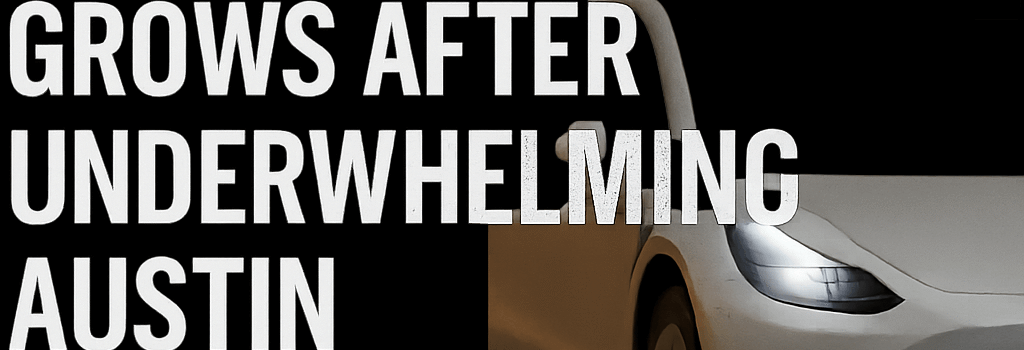Tesla Skepticism Grows After Underwhelming Austin Robotaxi Demo

The latest Electric Vehicle Intelligence Report (EVIR) survey reveals that U.S. consumers’ confidence in Tesla has hit new lows, driven by safety concerns, disappointing robotaxi demos in Austin, and rising competition in the autonomous vehicle (AV) space.
Survey Reveals Declining Brand Sentiment
In July 2025, EVIR polled 8,237 American drivers on EV adoption, autonomous driving, and automaker brand perceptions. Tesla—once synonymous with electric performance—registered only a 26% somewhat-or-very-positive favorability rating, while 39% viewed the brand negatively. With just 14% neutral or unfamiliar, Tesla’s net positive score plunged to −13 (down from −7 in April), and its view intensity (strong likes versus strong dislikes) sits at −16.
- Toyota leads EV brands with a net positive score of +25 and view intensity of +18.
- Vinfast—the only other brand in negative territory—remains unfamiliar to 92% of respondents.
Demographically, Tesla ranked lowest across income brackets, geographies, and age groups. Suburbanites and those earning under $75,000 expressed the greatest disdain, while consumers over 65 recorded the highest negative sentiment.
Safety Perception Plummets After High-Profile Crashes
Despite CEO Elon Musk’s repeated assertions of Tesla’s “industry-leading” safety, public trust has eroded. Just 52% now consider Teslas safe—the second-worst rating among surveyed EV makers, following Vinfast. Since January 2025, the National Highway Traffic Safety Administration (NHTSA) opened probes into at least 42 crashes involving Tesla’s driver-assist systems.
Robotaxi Demo Underwhelms in Austin
In late June, Tesla began limited robotaxi demos on Austin’s roads under Texas Senate Bill 220, which allows private AV testing with $1 million liability coverage. Yet public awareness is low: 65% of consumers were unaware of the program; only 3% felt well-informed.
EVIR data shows:
- 1% of respondents rode in a Tesla robotaxi and would ride again; another 1% would not.
- 21% said they would consider a robotaxi ride; 46% said they would never consider it.
- 53% became less convinced of Tesla robotaxi safety after reading a Wall Street Journal excerpt detailing issues like camera glare and high disengagement rates.
Technical Limitations of Camera-Only Approach
- Sensor suite: Eight 1.2 MP cameras with varying fields of view; no lidar or radar. Direct sun glare (>10 000 lux) can saturate image sensors, impairing object detection.
- Compute hardware: FSD Computer v2.5 uses Nvidia Xavier chips; v3 employs Tesla’s custom D1 ASICs delivering 36 TOPS each for neural-net inference.
- Perception accuracy: Monocular depth estimation error can reach ±0.5 m beyond 30 m, versus lidar systems’ ±0.1 m accuracy. Industry leaders like Waymo report <0.02 disengagements per 1,000 miles, compared to Tesla’s ~0.7.
Regulatory and Legal Landscape
Texas regulators have been permissive, but NHTSA’s ongoing investigations and California DMV proposals to suspend new FSD software licenses indicate mounting scrutiny. Legal experts warn that without transparent safety audits and sensor redundancy, Tesla may face additional recalls or restrictions.
Deep Dive: Dojo Supercomputer and Neural Net Training
Tesla’s Dojo cluster, powered by custom D1 training chips, achieves up to 4 PFLOPS of AI training throughput. It processes over 500 billion frames from fleet vehicles to train a 1.2 billion-parameter FSD neural network (v12). However, the gap between large-scale training in Dojo and real-time inference on in-car hardware presents latency and generalization challenges.
Expert Analysis and Competitive Outlook
“Tesla’s all-camera strategy increases risk profiles in complex urban environments,” says Dr. Sarah Lee, Senior Researcher at MIT’s Center for Autonomous Vehicles. “Fail-safe redundancy and multi-sensor fusion remain the industry standard.”
Waymo, Cruise, and Motional leverage lidar, radar, and high-definition mapping to achieve lower disengagement rates and stronger public trust. In Phoenix, Waymo has logged over 20 million autonomous miles with 0.09 disengagements per 1,000 miles.
Alternative Mobility Models and Market Impacts
As Tesla’s robotaxi aspirations stall, ride-hailing giants Lyft and Uber are partnering with AV startups to integrate Level 4 vehicles into their platforms. Revenue-sharing agreements and fleet management services could undercut Tesla’s direct-to-consumer fleet model.
Conclusions and Future Prospects
With consumer trust waning and regulatory pressures mounting, Tesla must address technical shortcomings—potentially by adding lidar or radar sensors, enhancing image-processing pipelines, and publishing transparent safety data—to regain its leadership in autonomous mobility. Otherwise, deep-pocketed competitors with proven L4 systems may capture the lucrative robotaxi market.